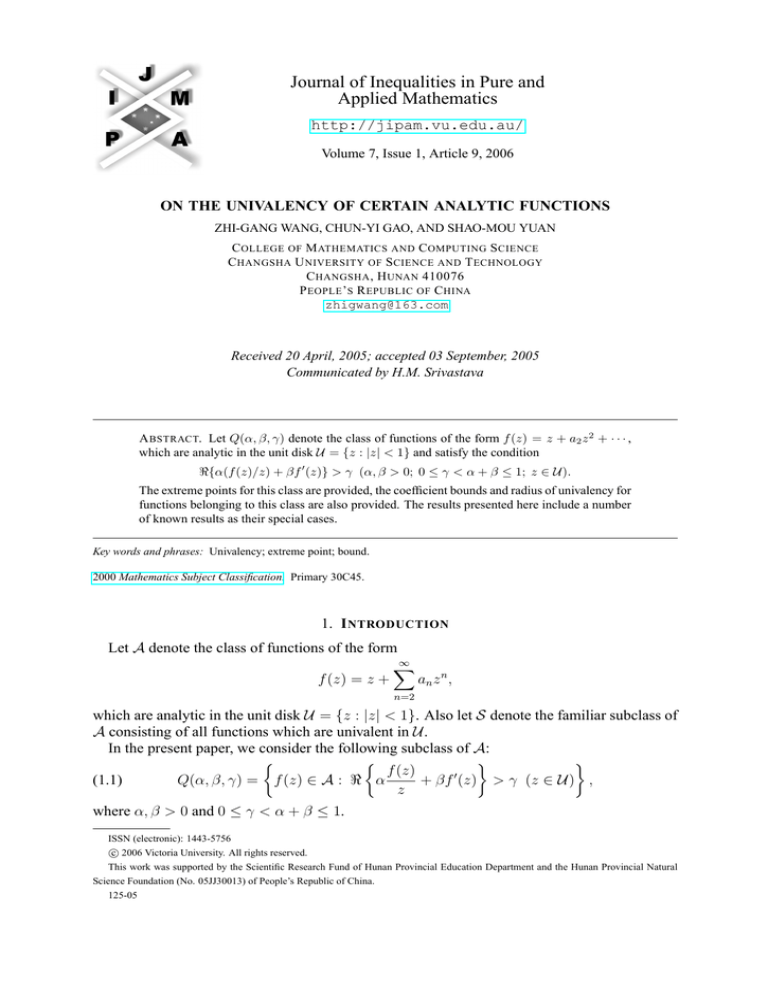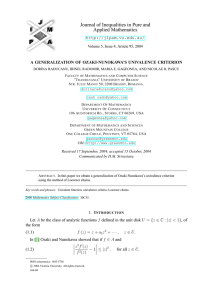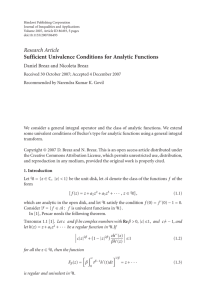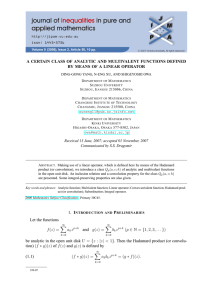
Journal of Inequalities in Pure and
Applied Mathematics
http://jipam.vu.edu.au/
Volume 7, Issue 1, Article 9, 2006
ON THE UNIVALENCY OF CERTAIN ANALYTIC FUNCTIONS
ZHI-GANG WANG, CHUN-YI GAO, AND SHAO-MOU YUAN
C OLLEGE OF M ATHEMATICS AND C OMPUTING S CIENCE
C HANGSHA U NIVERSITY OF S CIENCE AND T ECHNOLOGY
C HANGSHA , H UNAN 410076
P EOPLE ’ S R EPUBLIC OF C HINA
zhigwang@163.com
Received 20 April, 2005; accepted 03 September, 2005
Communicated by H.M. Srivastava
A BSTRACT. Let Q(α, β, γ) denote the class of functions of the form f (z) = z + a2 z 2 + · · · ,
which are analytic in the unit disk U = {z : |z| < 1} and satisfy the condition
<{α(f (z)/z) + βf 0 (z)} > γ (α, β > 0; 0 ≤ γ < α + β ≤ 1; z ∈ U).
The extreme points for this class are provided, the coefficient bounds and radius of univalency for
functions belonging to this class are also provided. The results presented here include a number
of known results as their special cases.
Key words and phrases: Univalency; extreme point; bound.
2000 Mathematics Subject Classification. Primary 30C45.
1. I NTRODUCTION
Let A denote the class of functions of the form
∞
X
f (z) = z +
an z n ,
n=2
which are analytic in the unit disk U = {z : |z| < 1}. Also let S denote the familiar subclass of
A consisting of all functions which are univalent in U.
In the present paper, we consider the following subclass of A:
f (z)
0
+ βf (z) > γ (z ∈ U) ,
(1.1)
Q(α, β, γ) = f (z) ∈ A : < α
z
where α, β > 0 and 0 ≤ γ < α + β ≤ 1.
ISSN (electronic): 1443-5756
c 2006 Victoria University. All rights reserved.
This work was supported by the Scientific Research Fund of Hunan Provincial Education Department and the Hunan Provincial Natural
Science Foundation (No. 05JJ30013) of People’s Republic of China.
125-05
2
Z HI -G ANG WANG , C HUN -Y I G AO ,
AND
S HAO -M OU Y UAN
In some recent papers, Saitoh [2] and Owa [3, 4] discussed the related properties of the
class Q(1 − β, β, γ). In the present paper, first we determine the extreme points of the class
Q(α, β, γ), then we find the coefficient bounds and radius of univalency for functions belonging
to this class. The results presented here include a number of known results as their special cases.
2. E XTREME P OINTS OF THE C LASS Q(α, β, γ)
First we give the following theorem.
Theorem 2.1. A function f (z) ∈ Q(α, β, γ) if and only if f (z) can be expressed as
"
#
Z
∞
X
1
(α + β)xn z n+1
(2.1) f (z) =
(2γ − α − β)z + 2(α + β − γ)
dµ(x),
α + β |x|=1
(n
+
1)β
+
α
n=0
where µ(x) is the probability measure defined on X = {x : |x| = 1}. For fixed α, β and γ,
Q(α, β, γ) and the probability measures {µ} defined on X are one-to-one by the expression
(2.1).
Proof. By the definition of Q(α, β, γ), we know f (z) ∈ Q(α, β, γ) if and only if
α(f (z)/z) + βf 0 (z) − γ
∈ P,
α+β−γ
where P denotes the normalized well-known class of analytic functions which have positive
real part. By the aid of Herglotz expressions of functions in P, we have
Z
α(f (z)/z) + βf 0 (z) − γ
1 + xz
=
dµ(x),
α+β−γ
|x|=1 1 − xz
or equivalently,
1
α f (z)
+ f 0 (z) =
β z
β
Z
|x|=1
α + β + (α + β − 2γ)xz
dµ(x).
1 − xz
Thus we have
Z z
α
α f (ζ)
−α
0
β
z
+ f (ζ) ζ β dζ
β ζ
0
Z z
Z
α
α
+
β
+
(α
+
β
−
2γ)xζ
1
−α
ζ β dζ dµ(x),
=
z β
1 − xζ
β |x|=1
0
that is,
1
f (z) =
α+β
Z
"
(2γ − α − β)z + 2(α + β − γ)
|x|=1
∞
X
(α + β)xn z n+1
n=0
(n + 1)β + α
#
dµ(x).
This deductive process can be converse, so we have proved the first part of the theorem. We
know that both probability measures {µ} and class P, class P and Q(α, β, γ) are one-to-one,
so the second part of the theorem is true. This completes the proof of Theorem 2.1.
Corollary 2.2. The extreme points of the class Q(α, β, γ) are
"
#
∞
X
1
(α + β)xn z n+1
(2.2)
fx (z) =
(2γ − α − β)z + 2(α + β − γ)
(|x| = 1).
α+β
(n + 1)β + α
n=0
J. Inequal. Pure and Appl. Math., 7(1) Art. 9, 2006
http://jipam.vu.edu.au/
O N THE U NIVALENCY OF C ERTAIN A NALYTIC F UNCTIONS
3
Proof. Using the notation fx (z), (2.1) can be written as
Z
fµ (z) =
fx (z)dµ(x).
|x|=1
By Theorem 2.1, the map µ → fµ is one-to-one, so the assertion follows (see [1]).
P
n
Corollary 2.3. If f (z) = z + ∞
n=2 an z ∈ Q(α, β, γ), then for n ≥ 2, we have
|an | ≤
2(α + β − γ)
.
nβ + α
The results are sharp.
Proof. The coefficient bounds are maximized at an extreme point. Now from (2.2), fx (z) can
be expressed as
(2.3)
∞
X
xn−1 z n
fx (z) = z + 2(α + β − γ)
(|x| = 1),
nβ + α
n=2
and the result follows.
Corollary 2.4. If f (z) = z +
P∞
n=2
an z n ∈ Q(α, β, γ), then for |z| = r < 1, we have
|f (z)| ≤ r + 2(α + β − γ)
∞
X
n=2
rn
.
nβ + α
This result follows from (2.3).
3. R ADIUS OF U NIVALENCY
In this section, we shall provide the radius of univalency for functions belonging to the class
Q(α, β, γ).
Theorem 3.1. Let f (z) ∈ Q(α, β, γ), then f (z) is univalent in |z| < R(α, β, γ), where
1
n−1
nβ + α
R(α, β, γ) = inf
.
n
2n(α + β − γ)
This result is sharp.
Proof. It suffices to show that
|f 0 (z) − 1| < 1.
(3.1)
For the left hand side of (3.1) we have
∞
∞
X
X
n−1 n |an | |z|n−1 .
nan z ≤
n=2
n=2
This last expression is less than 1 if
|z|n−1 <
nβ + α
.
2n(α + β − γ)
To show that the bound R(α, β, γ) is best possible, we consider the function f (z) ∈ A
defined by
2(α + β − γ) n
f (z) = z −
z .
nβ + α
J. Inequal. Pure and Appl. Math., 7(1) Art. 9, 2006
http://jipam.vu.edu.au/
4
Z HI -G ANG WANG , C HUN -Y I G AO ,
AND
S HAO -M OU Y UAN
If δ > R(α, β, γ), then there exists n ≥ 2 such that
1
n−1
nβ + α
< δ.
2n(α + β − γ)
Since f 0 (0) = 1 > 0 and
2n(α + β − γ) n−1
δ
< 0.
nβ + α
Thus, there exists δ0 ∈ (0, δ) such that f 0 (δ0 ) = 0, which implies that f (z) is not univalent in
|z| < δ. This completes the proof of Theorem 3.1.
f 0 (δ) = 1 −
R EFERENCES
[1] D.J. HALLENBECK, Convex hulls and extreme points of some families of univalent functions,
Trans. Amer. Math. Soc., 192 (1974), 285–292.
[2] H. SAITOH, On inequalities for certain analytic functions, Math. Japon., 35 (1990), 1073–1076.
[3] S. OWA, Some properties of certain analytic functions, Soochow J. Math., 13 (1987), 197–201.
[4] S. OWA, Generalization properties for certain analytic functions, Internat. J. Math. Math. Sci., 21
(1998), 707–712.
J. Inequal. Pure and Appl. Math., 7(1) Art. 9, 2006
http://jipam.vu.edu.au/












